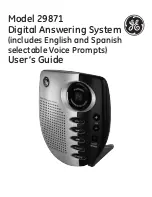Reviews:
No comments
Related manuals for 17570

HCD
Brand: Happy Pages: 9

3287
Brand: GE Pages: 52

AK85C
Brand: JUKI Pages: 5

Sweepmaster P1500 RH
Brand: HAKO Pages: 80

336K125
Brand: Singer Pages: 15

base hazer pro
Brand: HazeBase Pages: 9

Carpetmaster 577
Brand: Clarke Pages: 21

DR-7UW
Brand: NLI Pages: 36

BlastRazor Z-25RC
Brand: Contracor Pages: 40

79-1
Brand: Singer Pages: 30

SCRUBTEC 866
Brand: Nilfisk-ALTO Pages: 27

L-1C
Brand: JUKI Pages: 18

J-350QVP
Brand: JUKI Pages: 32

DLU-5494N-7
Brand: JUKI Pages: 4

LK-1900B series
Brand: JUKI Pages: 174

A230
Brand: Panasonic Pages: 377

OKIFAX 4100
Brand: Oki Pages: 16

MAGNUM series
Brand: R.P.S. Corporation Pages: 43

















